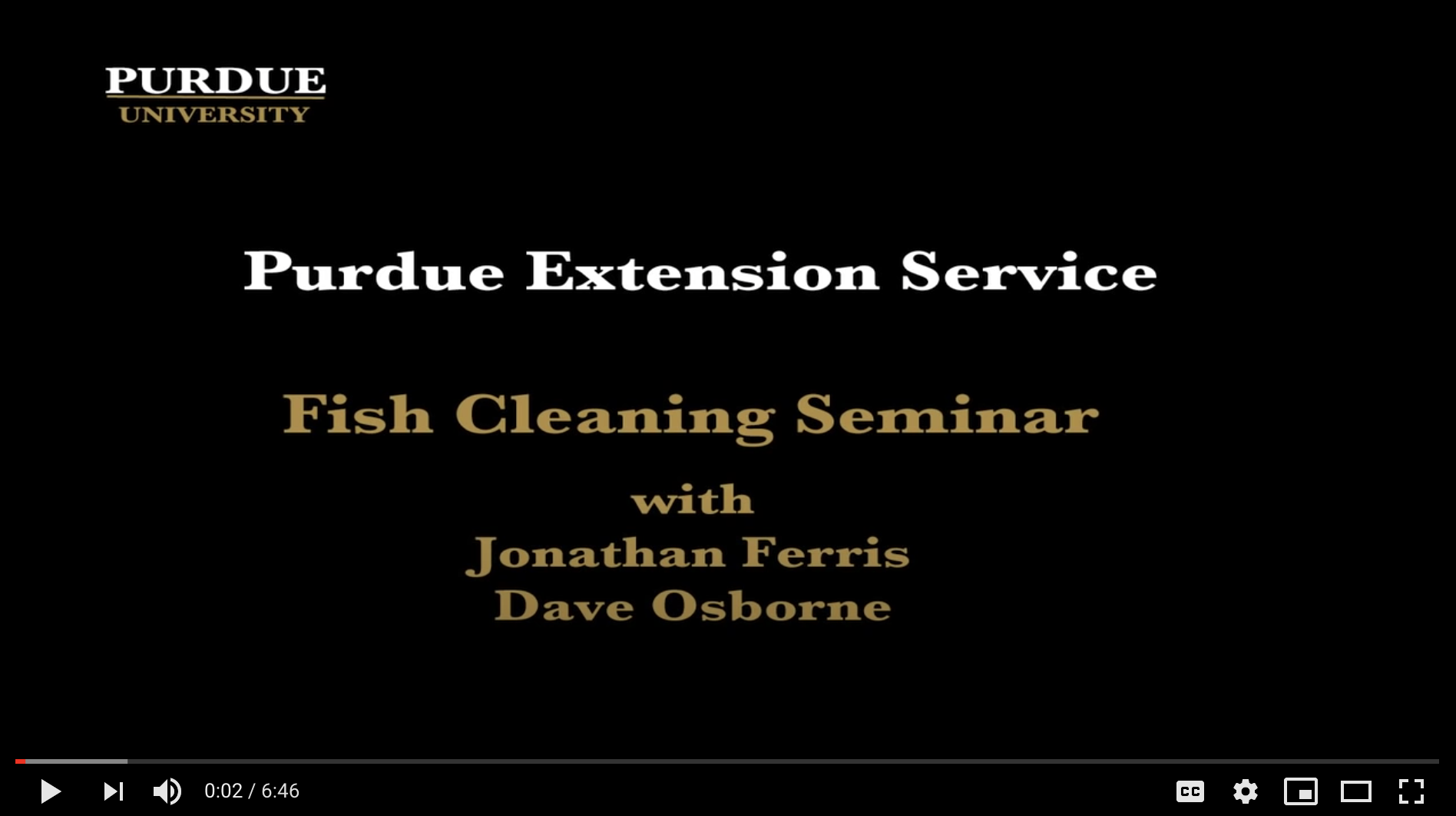 Purdue University - Extension - Forestry and Natural Resources
Purdue University - Extension - Forestry and Natural Resources
Got Nature? Blog
Welcome to the Nature of Teaching Professional Development Webinar Series: Ecotoxicology Part 1. This webinar shared by Rod Williams, a professor and extension wildlife specialist with Purdue University Extension, and Jason Hoverman, an associate professor at Purdue University and a co-author on the unit on ecotoxicology, discusses the principles of ecotoxicology, contaminants, and threats to the freshwater ecosystems.
This webinar shares the resources teachers, and K-12 leaders, need to teach students about ecotoxicology. This state standard curriculum includes free downloads of posters, photos, charts, data sheets, and fun activities along with the opportunity to receive a Certificate of Completion.
Resources
The Nature of Teaching: Ecotoxicology and Environmental Health, The Education Store, Purdue Extension’s resource center
Benefits of Connecting with Nature, The Education Store
The Nature of Teaching: Disease Ecology, The Education Store
Resourceful Animal Relationships, The Education Store
The Nature of Teaching, YouTube Channel
Nature of Teaching, Website
Rod Williams, Professor of Wildlife Science
Purdue University Department of Forestry and Natural Resources
Jason Hoverman, Associate Professor Vertebrate Ecology
Purdue University Department of Forestry and Natural Resources
“The best and the most meat on the fish lays right on top of the rib cage, right down the back”, Purdue Extension County Director Dave Osborne shares in this Fish Cleaning Seminar (Youtube video). Learn the basics of using a fillet knife and an electric fillet knife to clean the fish as he guides you through the process.
Resources
Pond and Wildlife Management, Purdue Extension website
Indiana Pond Fish, Species Identification Card Set, The Education Store, Purdue Extension Resource Center
Handling Harvested Game: Episode 1, Field Dressing, Video, Purdue Extension YouTube Channel
Handling Harvested Game: Episode 4, Cutting, Grinding & Packaging, Video, Purdue Extension YouTube Channel
Dave Osborne, County Extension Director
Purdue Extension
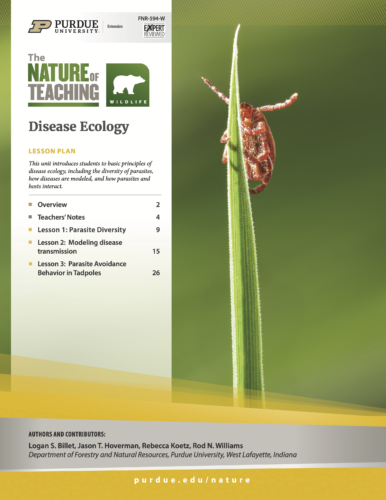 The Nature of Teaching: Disease Ecology is one unit in a series available from The Nature of Teaching – the place to go for teaching resources that focus on wildlife, food waste, health and wellness. In this series teachers can find free lesson plans, printables, posters, a photo library, information on upcoming workshops and more.
The Nature of Teaching: Disease Ecology is one unit in a series available from The Nature of Teaching – the place to go for teaching resources that focus on wildlife, food waste, health and wellness. In this series teachers can find free lesson plans, printables, posters, a photo library, information on upcoming workshops and more.
This unit introduces students to basic principles of disease ecology, including the diversity of parasites, how diseases are modeled, and how parasites and hosts interact. It includes three lessons with colorful animal cards to print along with worksheets and presentation.
Lesson 1: Parasite Diversity Activity
Lesson 2: Modeling Disease Transmission
Lesson 3: Parasite Avoidance Behavior in Tadpoles
This 33-page download PDF is written by Dr. Jason Hoverman; Logan Billet, Rebecca Koetz and Dr. Rod Williams.
For more resources, please check the Education Store.
Resources
Benefits of Connecting with Nature, The Education Store, Purdue Extension resource center
The Nature of Teaching: Ecotoxicology and Environmental Health, The Education Store
Resourceful Animal Relationships, The Education Store
The Nature of Teaching: Food Waste and the Environment, The Education Store
Rod Williams, Professor of Wildlife Science
Purdue University Department of Forestry and Natural Resources
Purdue Forestry & Natural Resources extension specialists gathered for a Facebook LIVE event held May 5th to answer questions on a wide range of topics from woodland management to wildlife habitat, ponds to invasive species and more.
Topics ranged from what to do about moles, voles and Canada geese causing damage in your yard, to how to pick the right tree for your landscape and how to measure the worth of your trees. The presentation also included segments on what to do about algae in your pond to how to know if you need to restock it as well as what to do about invasive plant species and how to protect your trees from deer damage.
Get advice from extension specialists Jarred Brooke, Lenny Farlee, Brian MacGowan, Lindsey Purcell, Rod Williams and Mitch Zischke in the video below.
If you have any further questions feel free to send your questions by submitting our Ask An Expert form.
Resources mentioned:
Purdue Extension – The Education Store
Purdue Report Invasive Species Website
Midwest Invasive Species Network Database
TreesAreGood.org
Find a Forester in Indiana
Improve My Property for Wildlife, Purdue Extension
Online Mole Program, Event May 14th, Purdue FNR Extension
Have you seen a hairless squirrel, Got Nature? Blog, Purdue FNR Extension
Stocking Fish, The Education Store, Purdue Extension Resource Center
Tree Selection for the “Un-natural” Environment, The Education Store
Selecting a Nuisance Control Operator, The Education Store
Forest Products Price Report (pdf), Indiana Department of Natural Resources (IDNR)
Indiana DNR Nuisance Goose Control Options (pdf), Indiana Department of Natural Resources (IDNR)
Turtles of Indiana, The Education Store
Salamanders of Indiana, The Education Store
Frogs and Toads of Indiana, The Education Store
Snakes and Lizards of Indiana, The Education Store
Aquatic Plant Management, The Education Store
Native Grasses, The Education Store
Preventing Deer Browsing on Trees/Shrubs, Video, Purdue Extension Youtube Channel
Brian MacGowan, Wildlife Extension Specialist
Purdue University, Department of Forestry and Natural Resources
With all of the recent rain we have had throughout the state, I have received several inquiries about effects on wildlife and what we can expect. While some flooding is natural in low areas and wildlife are adapted to respond, extreme flooding can impact wildlife. Flood waters can wash away nests or drown developing or very young animals for those living in low-lying areas. For example, heavy spring rains can reduce nest success of wild turkeys.
I have received several inquiries about effects on wildlife and what we can expect. While some flooding is natural in low areas and wildlife are adapted to respond, extreme flooding can impact wildlife. Flood waters can wash away nests or drown developing or very young animals for those living in low-lying areas. For example, heavy spring rains can reduce nest success of wild turkeys.
In many cases, wildlife will adapt by simply moving to higher ground. I tend to get an increase in inquiries about snakes after flooding. They begin showing up in neighborhood homes when they have never been observed in years past. Certainly our environment changes over time and wildlife can and do respond to these changes. However, sudden changes are likely due to a response of snakes moving to drier ground. The good news is this and other similar displacement of wildlife is usually temporary.
What can we do? I’m afraid not much for our currently flooded friends. However, in the long-term, times like this reinforce the need to create and enhance quality wildlife habitat. Providing wildlife with quality habitat that contains the necessary food, cover and water resources gives them a fighting chance to deal with issues that inevitably arise. In addition, wetlands that landowners build and restore on their properties not only enhance wildlife habitat, but also help retain moderate flood waters and recharge groundwater supplies.
If some unwanted wildlife has overstayed their welcome in and around your home, check out the Purdue Education Store publication, Considerations for Trapping Nuisance Wildlife with Box Traps. If you think you have found a sick or injured animal, you can find a list of licensed Wild Animal Rehabilitators in your area on the DNR Division of Fish and Wildlife’s Orphaned and Injured webpage. In Indiana, wildlife rehabilitators have necessary state and federal permits to house and care for sick or injured wild animals.
Additional Resources
Preventing Wildlife Damage – Do You Need a Permit? The Education Store, Purdue Extension
The Basics of Managing Wildlife on Agricultural Lands, The Education Store, Purdue Extension
Brian J. MacGowan, Extension Wildlife Specialist
Department of Forestry and Natural Resources, Purdue University
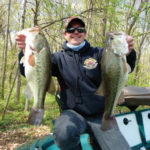 Fish stocking in a pond is like a retirement plan—you need to have a vision of your ultimate goal. You want to start off in the right direction or your long-term investment may not pay the dividends you had hoped for. Pond Management: Stocking Fish in Indiana Ponds is an 8-page publication written by our experts partnering together from Purdue’s Pesticide Programs, Forestry and Natural Resources and Purdue Weed Science. They share recommendations regarding fish types, numbers, and predator/prey relationships for new and renovated ponds.
Fish stocking in a pond is like a retirement plan—you need to have a vision of your ultimate goal. You want to start off in the right direction or your long-term investment may not pay the dividends you had hoped for. Pond Management: Stocking Fish in Indiana Ponds is an 8-page publication written by our experts partnering together from Purdue’s Pesticide Programs, Forestry and Natural Resources and Purdue Weed Science. They share recommendations regarding fish types, numbers, and predator/prey relationships for new and renovated ponds.
Main topics include:
- Stocking new or renovated ponds with no fish present
- Assessment of ponds with existing fish populations
- Northern strain largemouth bass
- Stocking fathead minnows
- Stocking fish to control vegetation
- Dissolved oxygen – fish need it to live
- Fish health
Properly stocking your pond with the correct number of the recommended species at the right size are all important steps in creating a healthy and well-balanced pond that will provide good fishing into the future. For more information on pond management go to extension.purdue.edu/pondwildlife or contact Dr. Mitchell Zischke at mzischke@purdue.edu.
Other resources:
Indiana Pond Fish, Species Identification Card Set, The Education Store, Purdue Extension Resource Center
Forestry and Water Quality: Pollution Control Practices, The Education Store
Marine Shrimp Biofloc Systems: Management Practices, The Education Store
The Nature of Teaching: Healthy Water, Happy Home – Lesson Plan, The Education Store
Aquaculture & Aquatics,Purdue Extension-Forestry & Natural Resources
Mitch Zischke, Clinical Assistant Professor
Purdue University, Department of Forestry and Natural Resources
 The Purdue Extension-Nature of Teaching has recently released a new publication through The Education Store. The Nature of Teaching provides free Indiana Academic Standard-based lesson plans for students in grades second through sixth to guide them on how to help maintain a healthy environment.
The Purdue Extension-Nature of Teaching has recently released a new publication through The Education Store. The Nature of Teaching provides free Indiana Academic Standard-based lesson plans for students in grades second through sixth to guide them on how to help maintain a healthy environment.
Understanding adaptations for aquatic amphibians can help humans learn more about healthy ecosystems. Through this educational unit, students will be able to explain how amphibian adaptations benefit survival, describe the importance of Eastern Hellbender adaptations, and identify impacts that humans have on aquatic amphibians.
These packed lesson plans are great resources for school teachers, parents, 4-H leaders and other natural resource educators. View the Adaptations for Aquatic Amphibians for the latest installment in the Nature of Teaching resources. See below for other related publications, lesson plans and games.
Resources
Frogs and Toads of Indiana, The Education Store, Purdue Extension
Salamanders of Indiana, The Education Store
Snakes and Lizards of Indiana, The Education Store
Turtles of Indiana, The Education Store
Help the Hellbender, Purdue Extension
Hellbender Havoc Game, Google Play, Hellbender Havoc Game – Apple iTunes Store
Hellbender Decline, Purdue Extension-FNR Youtube
The Nature of Teaching, Lesson Plans K-12, Purdue Extension
Nick Burgmeier, Extension Wildlife Specialist & Research Biologist
Purdue University Department of Forestry and Natural Resources

Photo by Brian MacGowan
As the weather begins to warm up later this year, the sight of Canada geese returning is pleasant to some as a reminder of spring approaching. It can also be downright irritating to others who experience property damage and other conflicts as the geese concentrate on their property. There are several strategies for dealing with geese listed in further detail at the Indiana Department of Natural Resources (IDNR) website, ranging from mild to severe.
The first thing that is important to know regarding geese is that it is simply not a good idea to feed them. While this act is positive in intention, it is a bad thing for both people and geese. Feeding geese gives them an artificially abundant source of food, which can cause them to delay or skip their migration and instead congregate in areas where they will conflict with people. Furthermore, being fed can cause geese to lose their fear of people, giving them the confidence to stroll across roadways and runways. Finally, large amounts of geese competing over bread and other food of limited nutritional value greatly increases their chances of developing and spreading avian diseases. The U.S. Fish & Wildlife Service‘s free publication “Caution: Feeding Waterfowl May Be Harmful!” further explains the need to stop feeding geese.
INDNR offers a significant amount of other advice on other methods of handling goose problems. Habitat modification such as adding vegetative barriers or suspended grid systems can be a good long term solution by making your land less attractive to geese. If geese have already begun to settle in, nonlethal harassment techniques like air horns and sprayers can be used twice a day to scare geese away from your property. Nests can be legally removed as long as there are no eggs present. If the situation calls for more severe actions, a permit can be acquired to destroy nests with eggs, or another permit can be issued by a District Wildlife Biologist to capture and relocate the animals. In cases of excessive property damage, a District Wildlife Biologist can also issue an agricultural depredation permit to shoot geese outside of the normal hunting season.
There are many methods of handling nuisance Canada geese this spring, and not one solution for every problem. If there is a goose problem in your area, please view INDNR’s Nuisance Canada Goose Management page to learn more about what you can do and how to acquire permits if needed.
Resources:
Nuisance Canada Goose Management – Indiana Department of Natural Resources (IDNR)
Caution: Feeding Waterfowl May Be Harmful! – U.S. Fish & Wildlife Service
Selecting a Nuisance Wildlife Control Professional, Got Nature? blog, Purdue Extension-Forestry & Natural Resources
Aaron Doenges, videographer & assistant web designer
Purdue Forestry and Natural Resources
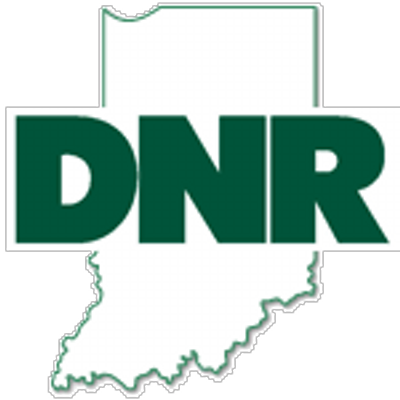 This summer, the Indiana Department of Natural Resources Division of Reclamation earned the 2015 Mid-Continent Regional Award from the U.S. Department of the Interior’s Office of Surface Mining, Reclamation and Enforcement (OSMRE) for their outstanding work in eliminating the abandoned Minnehaha slurry pond in an area of abandoned mine land in Sullivan County. This reward recognizes the elimination of health, safety and environmental problems in abandoned mine lands and is rightfully deserved by this ambitious project.
This summer, the Indiana Department of Natural Resources Division of Reclamation earned the 2015 Mid-Continent Regional Award from the U.S. Department of the Interior’s Office of Surface Mining, Reclamation and Enforcement (OSMRE) for their outstanding work in eliminating the abandoned Minnehaha slurry pond in an area of abandoned mine land in Sullivan County. This reward recognizes the elimination of health, safety and environmental problems in abandoned mine lands and is rightfully deserved by this ambitious project.
This project was one of the largest and most extensive projects that the Division of Reclamation has tackled in its over 30 years of work. To begin, the team addressed a weakened levee at the abandoned mine. The levee was holding back a pond of slurry, a hazardous mix of coal and water. By repairing this levee, a disastrous blackwater flood that could harm both property and people in the Sullivan County area was avoided.
The repaired levee allowed the team to then safely work on removing this abandoned slurry pond. A large sulfate-reducing bioreactor was built at the site, which treated and released over six million gallons of water through a newly designed system of sloping hills and a stream. By removing this slurry pond, this project succeeded in eliminating some of the waste caused from coal mining that is often neglected.
For more information, please check out Indiana DNR’s page on the project and award.
Resources
DNR Reclamation Earns National Award, Indiana Department of Natural Resources
Status of Reforested Mine Sites in S.W. Indiana, The Education Store, Purdue Extension Resource Center
Abandoned Mine Land Safety, Indiana Department of Natural Resources
Information for Citizens, Office of Surface Mining Reclamation and Enforcement
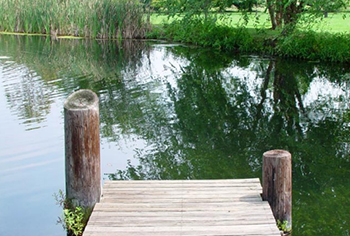
Photo credit: Dan Annarino
Hopefully no one is reading this after a catastrophic loss of their pond. This very wet summer has tested some ponds’ ability to hold and safely release excess water. I would like to quickly review the overflow structures ponds should have and also some management necessary to ensure the safety of ponds levees/dams.
For recreational ponds, there should be one or perhaps two means of releasing water from the pond. Most of these ponds are built on sloping land in order to capture rainwater to fill the pond. In this case, it is necessary to have an emergency spillway that will divert excess water once the pond is full away from the dam to prevent erosion and save the integrity of the structure. Usually they is just an earthen channel that runs around the end of the dam with an initial elevation 1-2 feet below the top of the dam. Water only runs through the spillway when the pond is full. An emergency spillway should have vegetation to prevent erosion but not to the extent that water is blocked from passing through efficiently.
A distinct advantage can be gained by having a drain structure installed through the dam when ponds are initially constructed. Drains such as this typically have a valve or swivel pipe which can regulate water level to whatever height the owner would like. With a wet summer such as we have had, the pond water level could be proactively lowered to save massive amounts of water passing through the spillway.
Additionally you can remove stagnant low oxygen water from the bottom of the pond. If a drain structure is releasing water from the bottom of the pond, it is a good idea to flush this valve two to three times per year to remove debris from around the structure which may plug it up if used infrequently. With these structures, it is a good idea to use the 6/12 rule. Water levels are kept six inches below maximum in order to catch any rain water event without overflowing. Evaporation and seepage will reduce the level back down over time. The 12 refers to the level the inches below maximum where you would add well water if you have the capacity. Generally this is only used with aquaculture ponds.
Control structures to maintain water levels will ensure the integrity of your ponds dams and levees. By controlling the amount of water flushing through a pond, the owner can also manage the productivity of the pond ecosystem by releasing/maintaining nutrients in the pond.
Resources
Commercial Greenhouse and Nursery Production: Controlling Algae in Irrigation Ponds, The Education Store, Purdue Extension Resource Center
Indiana Ponds, The Education Store
Indiana Ponds Q&A, The Education Store
Management of Ponds, Wetlands, and Other Water Reservoirs to Minimize Mosquitoes, The Education Store
Indiana Pond Management, Indiana Department of Natural Resources (IDNR), Fish & Pond Management
Ponds – Planning, Design, Construction, USDA Natural Resources Conservation Service (NRCS)
Bob Rode, Extension Aquaculture Specialist
Department of Forestry and Natural Resources, Purdue University
Recent Posts
- 2024-25 Fishing Guide now available – Wild Bulletin
Posted: April 4, 2024 in Alert, Aquaculture/Fish, Aquatic/Aquaculture Resources, How To, Ponds, Wildlife - Paddlecraft Wildlife Index – MyDNR
Posted: May 8, 2023 in Aquatic/Aquaculture Resources, Great Lakes, Ponds, Safety - Natural Resources University Podcasts Earn ANREP Gold Award
Posted: April 14, 2023 in Podcasts, Ponds, Timber Marketing, Wildlife, Woodlands - A Moment in the Wild: American Toad
Posted: May 31, 2022 in Ask the Expert, Ponds - Canada Geese Begin Scouting For Nesting Areas in February
Posted: January 31, 2022 in How To, Ponds, Wildlife - Ask an Expert: Aquatic Plant Management
Posted: July 6, 2021 in Aquaculture/Fish, Aquatic/Aquaculture Resources, Ask the Expert, How To, Plants, Ponds - A Moment in the Wild: Eastern Newt
Posted: July 2, 2021 in Aquaculture/Fish, Ponds - Ask an Expert: Enjoying Indiana Herps
Posted: June 1, 2021 in Aquaculture/Fish, Aquatic/Aquaculture Resources, Ask the Expert, How To, Ponds - A Moment in the Wild: Ephemeral Wetlands
Posted: May 3, 2021 in Ponds, Wildlife - Yellow Perch Becoming Popular
Posted: March 11, 2021 in Aquaculture/Fish, Aquatic/Aquaculture Resources, How To, Ponds, Publication
Archives
Categories
- Alert
- Aquaculture/Fish
- Aquatic/Aquaculture Resources
- Ask the Expert
- Christmas Trees
- Community Development
- Disease
- Drought
- Forestry
- Forests and Street Trees
- Gardening
- Got Nature for Kids
- Great Lakes
- How To
- Invasive Animal Species
- Invasive Insects
- Invasive Plant Species
- Land Use
- Natural Resource Planning
- Nature of Teaching
- Plants
- Podcasts
- Ponds
- Publication
- Safety
- Timber Marketing
- Uncategorized
- Urban Forestry
- Webinar
- Wildlife
- Wood Products/Manufacturing
- Woodland Management Moment
- Woodlands
